Conversation with Marie Topp
March 2025, Ingeborg Zackariassen
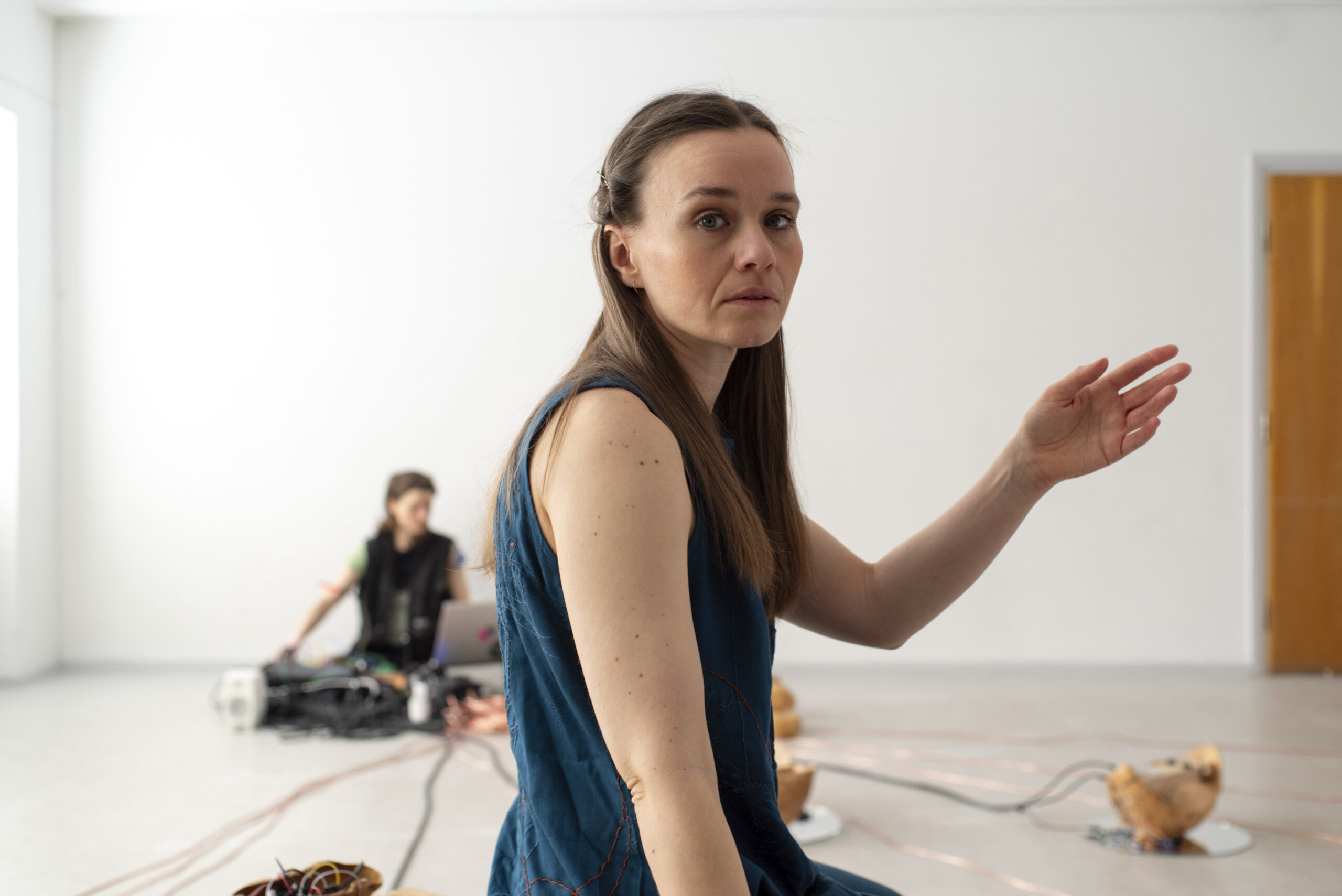
Marie Topp is about to present the second work in her recent trilogy, which investigates different aspects of time. Maze, a soundning and moving installation co-signed Julia Giertz; has it Göteborg-premiere at 3:e Våningen on the 3rd of April.
Marie was born and raised in Copenhagen, and got her dance education there, at what used to be called is now called the Danish National School of Performing Arts. She has lived in Stockholm, but moved back to Copenhagen 6 years ago. She started developing her own choreographic work already 13 years ago, and has since continued to refine her voice, especially during the course of the last decade.
The Gothenburg sky is cloudy and grey outside the window of my home office when I open the computer window to speak to Marie for the first time.
She greets me from her apartment, and I observe the slightly more spring-like Copenhagen light falling diagonally on her, while the wall next to her, in half darkness, full of framed paintings, creates the backdrop for our conversation.
I ask Marie if she can tell me a bit about her background as a choreographer, and she tells me that her solo practice has grown into different formats and collaborations. The trilogy she is currently deeply invested in, is being developed together with two of her close collaborators over the years; Julia Giertz and Mårten Axelsson. The three of them studied together at the Danish School of Performing Arts, and that she and Julia Giertz, the composer of the works, completed the dance education together, parallel to Mårten Axelsson getting his education as a light designer in the same university. According to Marie, the three of them having this shared background has had a huge influence on how they have developed the work together.
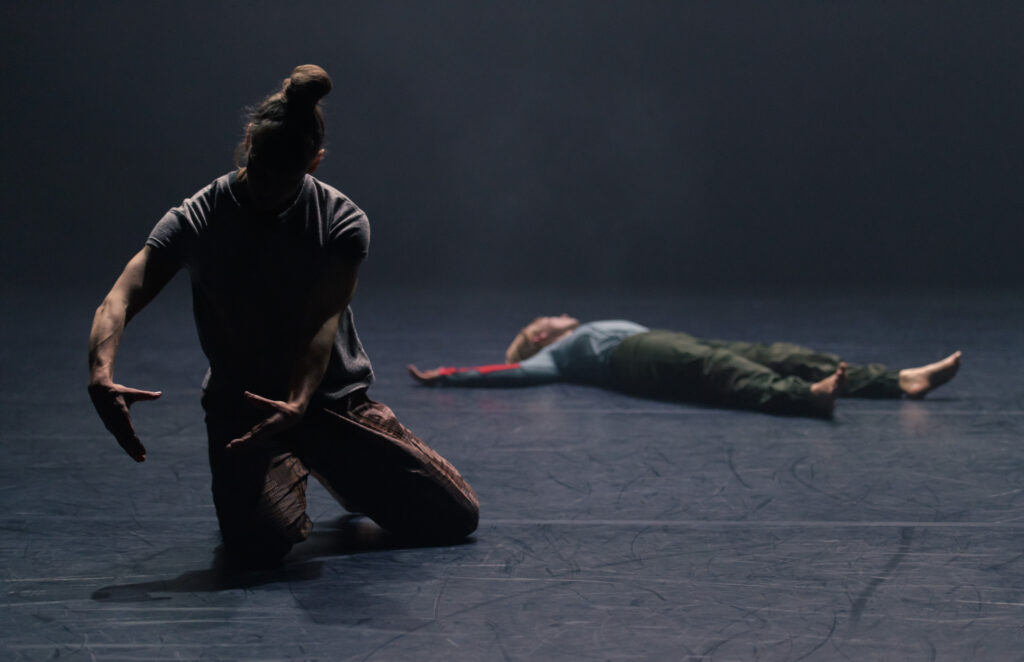
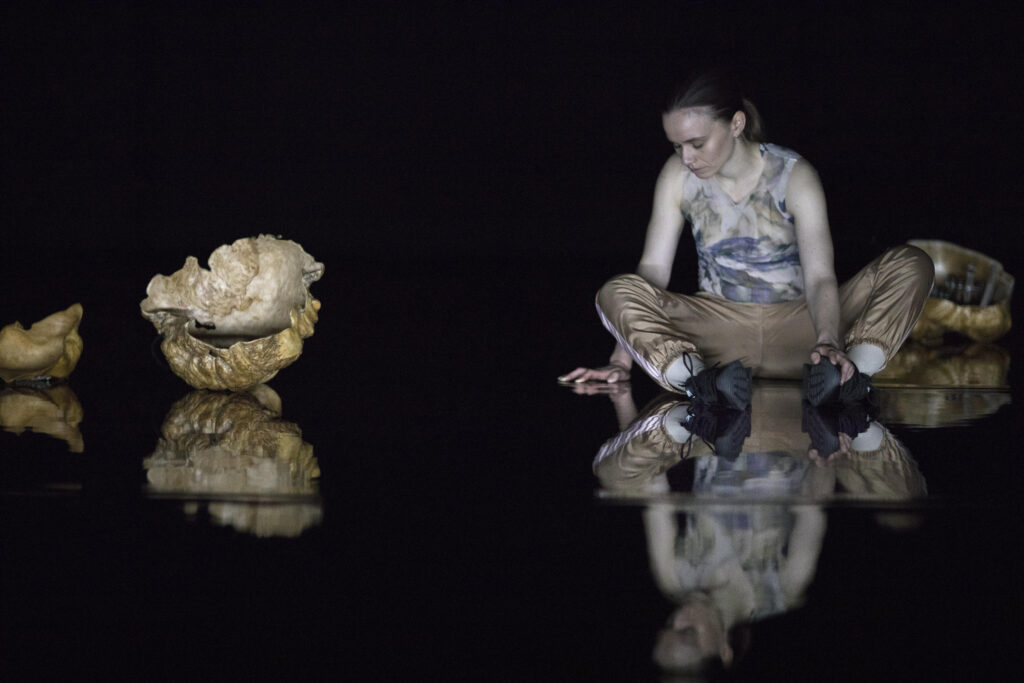
Photo: Søren Meisner, Lina Ikse
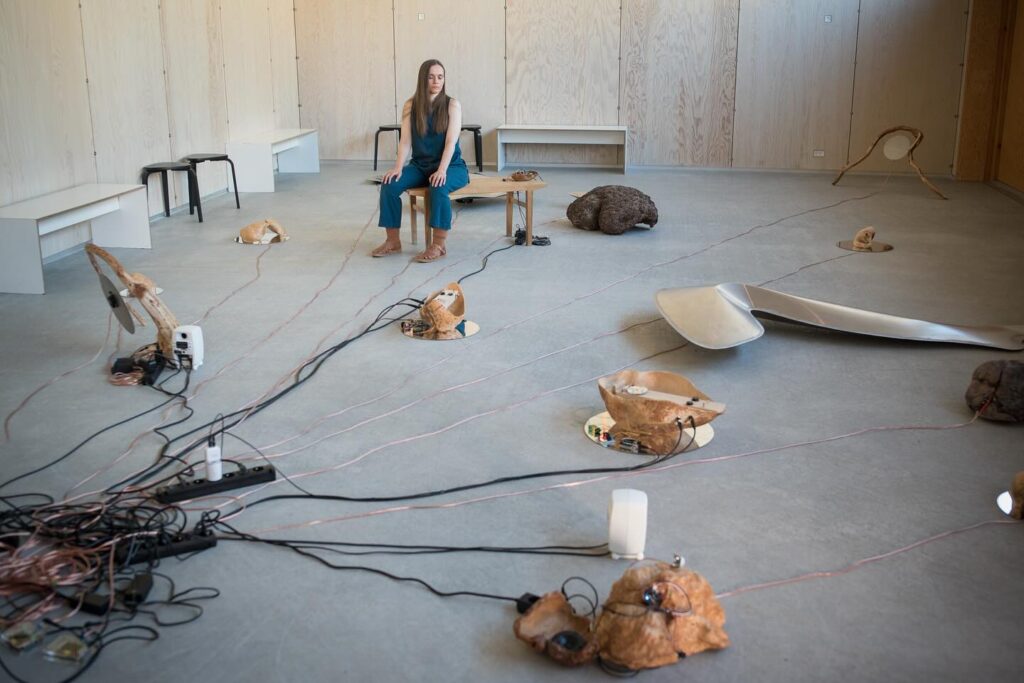
Photo: Thomas G. Bagge
When Maze premiered in Copenhagen in 2023, it was a durational performance of 3 hours, where the audience came and went while Marie was constantly interacting with the room and the installation. At 3:e våningen the audience will experience a slightly shorter version of Maze, which in one sense is a solo, but as Marie points out, she’s performing it together with an installation. A lot of focus has been put on the materials and their resonance, and she describes it as there being more than one performer, but her being the only human.
When Marie first started creating choreographic work, for the first three pieces, she found herself delving deep into the format of the solo.
– There’s something in the solo which opens up for imagination. Since the solo performer is not in a relation to any other person on stage, this one person becomes the catalyst for what the audience sees. This is something which opens up for potential transformation.
Marie explains that often, on stage human relationships between the performers can become an obstacle, something that distracts both performers and spectators away from the core elements of the work. She believes in keeping that sensibility and open up the work for the energetic space between them. She is always curious about how the work can “open itself”, and sees the risk in dense and meditative spaces that the work can close in on itself and therefore become harder to access. She wants to keep it open, and in the solo format she sees the possibility that a space really opens up towards the invisible potential between the audience and the performer.
– There is a moment when the mind starts to wander, and you see your own subconscious…
Marie sees this audience experience as quite unique for the solo format; the confrontation between oneself and the performer holds a different complexity.
– Presence is everything.
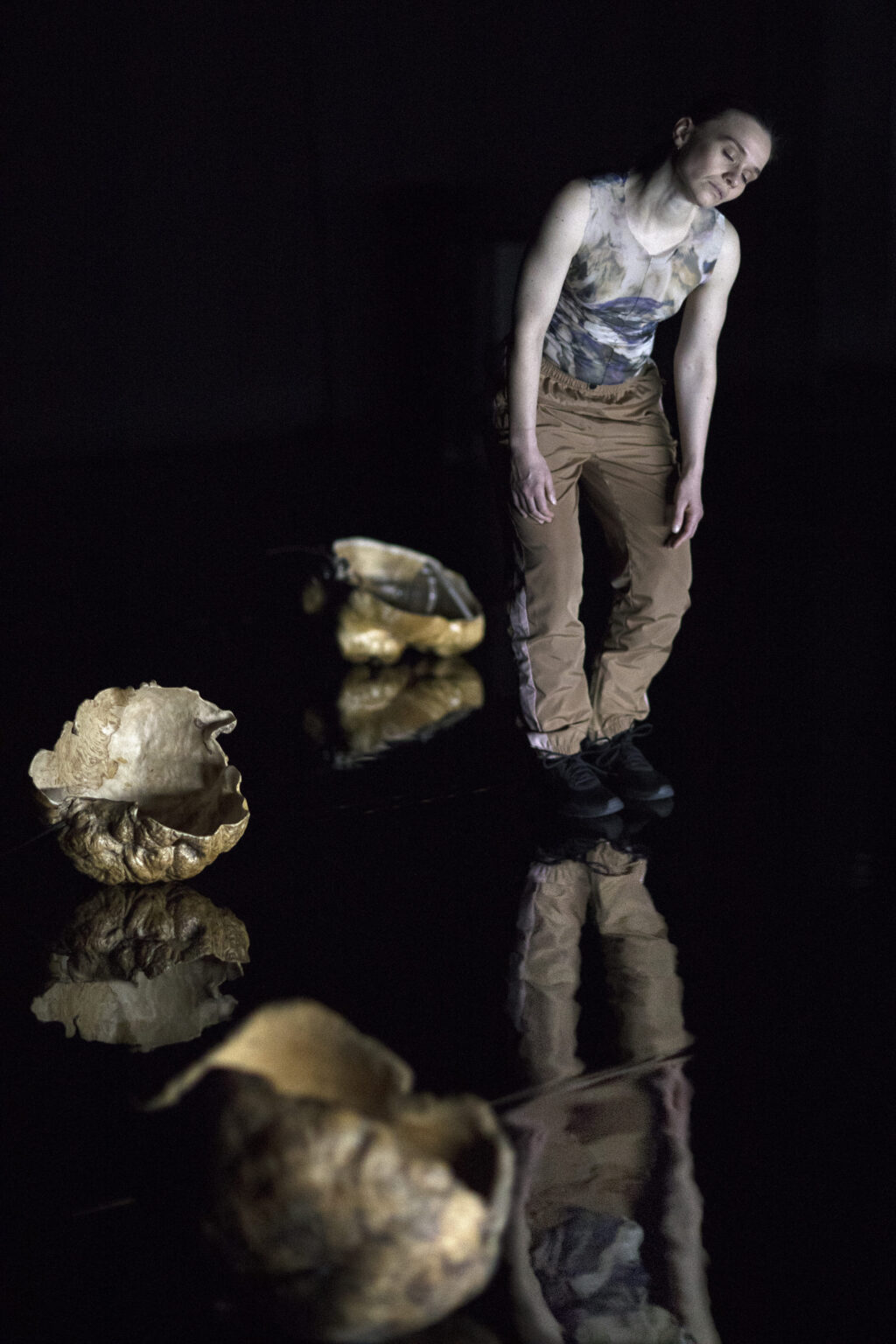
Photo: Lina Ikse
When I ask Marie about her relationship with improvisation, she explains that she uses improvisation in a the sense of how to enter the core material, as well as specific ways of relating to how the gaze is used and how the mind wanders. Another crucial element in Marie’s work is the weight distribution and the translation from how her body feels and how she works with her emotions in the moment. That is something which is constantly in transformation.
– Since I know the movement vocabulary, the shapes, the “parkour” of the work, I can let myself be held by the music. All elements are alive.
Marie believes that in order to be creative, you need to analyze what you’re doing ahead of the act of performing. The goal is to create a choreography that has so much clarity that you, as a performer, can spend your time being busy with the present moment.
– Maze is co-signed by Julia Giertz, and is created as a meeting point between our artistic practices. It is the second of three pieces, of which the third and final one actually premieres in Copenhagen in May.
– This time we really wanted to step away from the choreographer-led process, to challenge our practices.
The two of them have worked together for a long time, and have developed dramaturgical tools on the way. Marie says they are really getting to know themselves through the process of crafting these pieces. As Maze was made with the idea of being a durational installation, the process was built in the way of simultaneously building the instruments, the environment and the situation, Then they wanted to create choreographic material that could be equalised with the other elements, and the whole process has been a very close collaboration.
Julia has built all the resonators and instruments. She has her own artistic practices and processes which she has continued developing since the premiere of another collaboration of theirs, Oceanic.
On her website, I read about Julia’s relationship to sound: – To listen is not only an auditory process; it sharpens and shapes our attention, a subjective translation of information. Listening is a continuum of relationships.
Marie tells me that Julia uses string instruments, and often works with multi channel projects. Oceanic premiered at Atalante in 2020, and was presented in a classic blackbox-setting. In the work with the trilogy, the duo wanted to bring the audience closer, to create a fuller immersion into the embodied listening that the work offers. Marie explains that the physical, choreographic material really came out of the experience of being in this soundscape. As much as it moved her physically, it also stirred her inner journey.
– It wasn’t the easiest process from the start, with the distance between Stockholm and Copenhagen as well as having small children to take care of. It was difficult to work that way… – in fact it was a logistic nightmare, she laughs. But the duo got support by Milvus, who have supported them before as well, something she expresses a lot of gratitude towards. – MARC [Milvus Artistic Research Center, run by Rachel Tess, based in Knislinge] provided a space to meet somewhere in the middle, to develop Maze, which premiered in 2023.
The first piece of the trilogy, Labyrinth, was made in Copenhagen and premiered in Dansehallerne 2022. Marie, who had struggled with the conflicting feeling of being pregnant during covid, experienced a strong realisation when the theaters finally opened again.
– When I experienced [art]work, as well as the thinking that I could dwell in through these works, I felt so grateful. I felt reborn as audience, in terms of being grateful for the experience and the thinking these spaces can hold. In these difficult times it can seem like “why do we do this?” But I deeply believe that it truly allows another kind of thinking.
Marie thinks that the kinds of spaces that art offer are becoming more and more important, as a counter balance of the development of the digital and artificial intelligences.
– The ability to focus, to allow yourself to fall into deeper knowledge, the action of being together and respecting each other and holding a space together…
To make work, to try and figure things out and doing it together as a group… I find it deeply touching.
She thinks that art is becoming more and more important also politically. As so many of us, Marie started out just wanting to dance, just wanting to perform. But that drive has turned into something much bigger.
– At this point, our human ability to focus is so destroyed that theatre is one of the last spaces that we can get away from our phones. And that is SO important. That is really something that drives me.
– In my work I can be personal and emotional, even private. That puts the work in a high risk zone. It’s not a high pace, and you need to allow yourself to get into it as an audience member, and some people can’t and some don’t feel invited enough unfortunately, but it’s a risk I’m willing to take. I need to keep practicing this way of navigating through the unknown and figuring it out, because I don’t like it when the conclusion is already there.
In Maze, one of the elements Marie uses is eye contact with each audience member. The practice of dancing and the way the sound resonates in her is how the installation is constructed. Julia is also present, she is playing the installation live, and there is a sensing between them which derives from their shared practice.

Photo: Søren Meisner
What all pieces in the trilogy have in common is that they all deal with time; with different experiences of time in different phases of life.
The first one, Labyrinth, was, as Marie describes it a response to the sensation that hit her mid life becoming a mother, and simultaneously dealing with loss.
– It felt like time sped up, like my perception of time changed. It felt like tumbling through; like the distance between birth and death became shorter. She explains having become acutely aware of the forward “motor” of development and our human vulnerability.
– Through birth comes another relationship to death.
Maze has a different concept, the circular one, in which things come back, and in which eternity exists in every second. It’s a conceptual approach to time, in contrast to the process of pregnancy and Labyrinth, in which there was a forward, tumbling sensation.
The last piece in the trilogy is True random, which will premiere in Dansehallerne.
– This work is trying to embrace the experience of time when you are close to an end. It is a very present emotional state.
We are living in this paradigm change, and there is an insecurity in how the world is organised, I think this is transforming our experience of time.
“Time is out of joint” Shakespeare wrote in Hamlet, in the same scene is the famous “Something is Rotten in the State of Denmark” and I have borrowed that quote as a starting point for this new work.
Marie is concerned about how we relate to each other in the midst of geopolitical risks, climate catastrophe and AI.
– There is transformation. How does it change our relations? This anxiety has a strong physicality, which connects to being ungrounded, and not being able to grasp the moment… The feeling of being close to the end…
In Marie’s honest presence I can sense a glimmer of hope amongst her worry. That is confirmed when I read a text based on conversations during the process of creating Maze, penned one of Marie’s long time collaborators, dramaturge Igor Dobričić:
– As it is often the case inside the maze, we keep moving backward in order to move forward in more than one sense:
We are retreating toward death so that we can discover how to live…
…We are inviting you to be invited by you.
We are seeing you in order to be seen.
Because what was before will come back again,
as new.
Or at least – that is our hope.
Igor Dobričić
Maze will be shown at 3:e Våningen 3rd–5th of April 2025.
True Random premieres in Dansehallerne 24th of May 2025.
More information: https://dansehallerne.dk/en/public-program
Further reading:
Marie Topp: https://marietopp.dk/
Julia Giertz: https://juliagiertz.info/